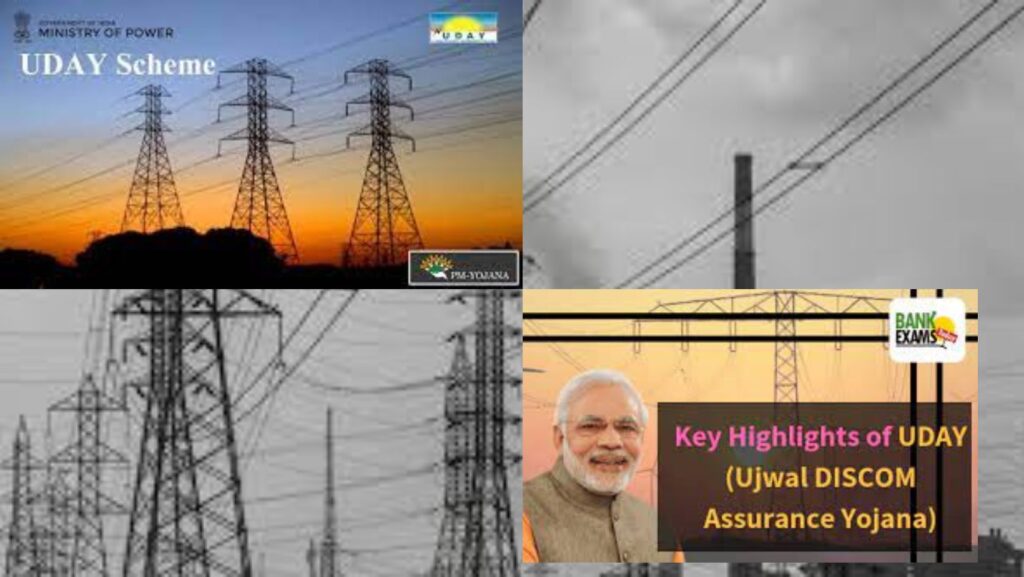
Power distribution companies (DISCOMs) in India are currently facing significant difficulties, including accumulated losses and unpaid debts. These financial challenges have resulted in inadequate power supply at affordable rates, negatively impacting the quality of life for people and hindering overall economic growth and development. Addressing the challenges faced by DISCOMs is crucial for achieving important goals such as complete electrification of villages, round-the-clock power supply, and the adoption of clean energy. Power outages also have adverse effects on national initiatives like “Make in India” and “Digital India.” Additionally, if financially stressed DISCOMs default on bank loans, it can have serious implications for the banking sector and the entire economy.
To tackle these challenges, the Government of India introduced a program called UDAY (Ujwal DISCOM Assurance Yojana) on November 20, 2015. UDAY aims to provide a sustainable solution for the financial and operational recovery of DISCOMs. The scheme incorporates reform measures in various sectors, including power generation, transmission, distribution, coal, and energy efficiency.

Key features of the UDAY scheme
- Financial and operational recovery: The scheme aims to offer a permanent solution for the outstanding debts of DISCOMs.It also addresses potential future losses.
- Initiatives for achieving break-even: DISCOMs are empowered to achieve a break-even point within 4-5 years through four key initiatives.
These initiatives include enhancing operational efficiency through measures such as smart metering and infrastructure upgrades, reducing the average AT&C (Aggregate Technical and Commercial) losses, lowering the cost of power by increasing the supply of cheaper domestic coal, and ensuring financial recovery by the states taking over 75% of DISCOM debt.
- Debt takeover and restructuring: States participating in the scheme are required to take over 75% of DISCOM debt as of September 30, 2015. The interest cost on the debt taken over by the states is reduced to around 8-9%, down from as high as 14-15%. The remaining DISCOM debt can be converted into loans or bonds with an interest rate not exceeding the bank’s base rate plus 0.1%. Alternatively, the DISCOMs can issue state-guaranteed DISCOM bonds at prevailing market rates, which should be equal to or less than the bank’s base rate plus 0.1%.
- Incentives and disincentives: The scheme provides incentives and disincentives based on the future financial performance of participating states. States are required to take over and finance at least 50% of DISCOM losses in a phased manner. States that achieve operational milestones will receive additional/priority funding through various schemes of the Ministry of Power and Ministry of New and Renewable Energy. However, states that fail to meet operational milestones may lose their entitlement to certain grants.
Participation and progress under the UDAY scheme
The UDAY scheme has seen participation from several states, with some signing comprehensive agreements and others joining based on operational parameters. Bond issuances under the scheme have also taken place, with states and DISCOMs raising significant funds. The scheme has already shown promising results, including a reduction in AT&C losses, power purchase costs, and the gap between Average Cost of Supply (ACS) and Average Revenue Realized (ARR). DISCOMs in some states are on track for recovery, and progress has been made in areas such as LED bulb distribution, feeder metering, household electrification, and renewable energy capacity.
UDAY 2.0
The ‘UDAY 2.0’ scheme was introduced by the Indian government in the Union Budget 2020-21. Its primary goals include the installation of smart prepaid meters, ensuring timely payments by power distribution companies (DISCOMs), guaranteeing the availability of coal in the short term, and reviving gas-based power plants. Finance Minister Nirmala Sitharaman also proposed a scheme worth Rs. 3.05 lakh crore (US$ 41 billion) to revive DISCOMs and give electricity consumers the option to choose their service providers. The implementation of this scheme will span five years.
To address the financial impact of the COVID-19 pandemic on DISCOMs, the central government introduced the liquidity infusion scheme as part of the ‘Aatmanirbhar Bharat Abhiyan’ on May 13, 2020. Due to the nationwide lockdown, DISCOMs faced a significant decline in revenue as people were unable to pay their electricity bills. To tackle this issue, DISCOMs were granted loans totaling Rs. 1.35 lakh crore (US$ 18 billion), with Rs. 46,321 crore (US$ 6.16 billion) already disbursed under the liquidity infusion scheme as of March 2021.
Power Finance Corporation (PFC) and Rural Electrification Corporation Ltd. (REC) have also provided special long-term transition loans to DISCOMs at concessional rates. These loans were given based on DISCOMs’ outstanding payments from state governments, including electricity dues and subsidies that were not distributed. The purpose of these loans was to enable DISCOMs to clear their outstanding dues towards Central Public Sector Undertaking (CPSU) Generation (GENCO) & Transmission Companies (TRANSCOs), Independent Power Producers (IPPs), and Renewable Energy (RE) generators as of June 30, 2020.
Moreover, the Government of India allowed a one-time relaxation for PFC and REC Ltd. to extend loans to DISCOMs that did not have sufficient headroom under the working capital limits imposed by the UDAY scheme or adequate receivables from state governments.
Looking ahead, DISCOMs face the need for tariff reforms to address the decrease in electricity demand caused by COVID-19 lockdowns. The implementation of the Electricity (Amendment) Bill 2020, along with measures to ensure cost-reflective tariffs and promote operational efficiency, is crucial. The integration of new models of renewable energy, storage technology, smart metering, and smart grids will also play a significant role in accelerating India’s transition to green energy.
The Indian government aims to have enough generation capacity to meet future electricity demands. By 2026-27, the projected all-India power generation installed capacity is estimated to be 6,19,066 MW, comprising 2,38,150 MW from coal, 25,735 MW from gas, 63,301 MW from hydro, 16,880 MW from nuclear, and 2,75,000 MW from renewable energy sources. Additionally, a study by the Central Electricity Authority predicts that the likely all-India power generation installed capacity in 2029-30 will be 8,17,254 MW, including 2,66,911 MW from coal, 25,080 MW from gas, 71,128 MW from hydro, 18,980 MW from nuclear, and 4,35,155 MW from renewable energy. The government aims to increase the share of renewable energy to meet India’s needs and potentially export to neighboring countries.
As the power sector undergoes a transformation towards renewable energy, the development of green corridors will become increasingly important to support new projects. While conventional energy sources will still have a role, the renewable sector will offer growing business opportunities. This shift will require strong distribution utilities capable of adapting to new technologies and market conditions. Power sector financial institutions like Power Finance Corporation Ltd. (PFC), Rural Electrification Corporation Ltd. (REC), and others may find the UDAY scheme to be a valuable tool in this transition.
Conclusion
The UDAY scheme, introduced by the Government of India, has been instrumental in addressing the financial challenges faced by power distribution companies (DISCOMs) in India. Through financial and operational recovery measures, debt takeover and restructuring, and incentives for achieving break-even, the scheme aims to provide a sustainable solution for DISCOMs. The UDAY scheme has already shown promising results, with participating states making progress in areas such as reducing losses, improving operational efficiency, and adopting renewable energy.
The introduction of UDAY 2.0 further emphasizes the importance of ensuring timely payments, installation of smart meters, availability of coal, and reviving gas-based power plants. The scheme aims to revive DISCOMs and empower electricity consumers with the option to choose their service providers. Additionally, measures have been taken to address the financial impact of the COVID-19 pandemic on DISCOMs through liquidity infusion and special transition loans.
Looking ahead, tariff reforms, cost-reflective tariffs, and the integration of renewable energy and smart technologies will play a crucial role in India’s transition to a sustainable and resilient power sector. The government’s focus on increasing generation capacity and developing green corridors demonstrates its commitment to renewable energy and meeting future electricity demands.
In conclusion, the UDAY scheme and its subsequent iterations serve as important tools for empowering India’s power distribution companies and supporting the country’s transition towards a greener and more reliable power sector
Official Web Site Click Here
This Web Site Click Here
Read More

One thought on “UDAY (Ujwal DISCOM Assurance Yojana): Empowering India’s Power Distribution Companies”